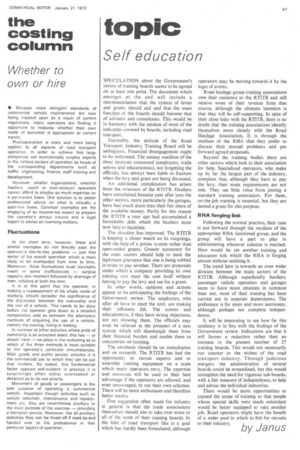topic
Page 49

If you've noticed an error in this article please click here to report it so we can fix it.
Self education
SPECULATION about the Government's review of training boards seems to be agreed on at least one point. The document which emerges at the end will include a recommendation that the system of levies and grants should end and that the main function of the boards should become that of advisers and consultants. This would be in harmony with the opinion of most of the industries covered by boards, including road transport.
Inevitably, the attitude of the Road Transport Industry Training Board will be ambiguous. Financial disengagement ought to be welcomed. The uneasy coalition of the three interests concerned (employers, trade unions and educationists), not forgetting the officials, has always been liable to fracture when the levy and grant are being discussed.
An additional complication has arisen from the structure of the RTITB. Hauliers have complained because year after year the other sectors, more particularly the garages, have had much more than their fair share of the available money. Partly for this reason the RTITB a year ago had accumulated a formidable debt which the hauliers must now help to liquidate.
The situation has improved. The RTITB is keeping a closer watch on its outgoings, with the help of a points system rather than open-ended grants. Greater autonomy for the main sectors should help to meet the legitimate grievance that one is being robbed in order to pay another. There are proposals under which a company providing its own training can meet the cost itself without having to pay the levy and sue for a grant.
In other words, opinions and actions appear to he anticipating the findings of the Government review. The employers, who after all have to meet the cost, are making their influence felt. The unions and educationists, if they have strong objections, are not showing them. The officials may even be relieved at the prospect of a new system which will disentangle them from their financial burden and enable them to concentrate on training.
The emphasis should be on consultation and on research. The RTITB has had the opportunity to recruit experts and to assemble training equipment on a scale which many operators envy. The expertise and resources will be used to their best advantage if the operators are allowed, and even encouraged, to run their own schemes. There will be more enthusiasm and therefore better results.
One suggestion often made for industry in general is that the trade associations themselves should aim to take over some or all of the work of their training boards. In the field of road transport this is a goal which has hardly been formulated, although operators may be moving towards it by the logic of events.
Road haulage group training associations owe their existence to the .RTITB and still receive some of their revenue from that source, although the ultimate intention is that they will be self-supporting. In spite of their close links with the RTITB, there is no doubt that the training associations identify themselves more closely with the Road Haulage Association, It is through the medium of the RHA that they prefer to discuss their mutual problems and put forward agreed proposals.
Beyond the training bodies there are other sectors which look to their association for help. Specialized operators, who make up by far the largest part of the industry, complain that, although they have to pay the levy, their main requirements are not met. They see little value from joining a standard training association. For them, on-the-job training is essential, but they are denied a grant for this purpose.
RHA forging link
Following the normal practice, their case is put forward through the medium of the appropriate RHA functional group, and the group will have a part to play in administering whatever solution is reached. Here would be yet another training and education link which the RHA is forging almost without realizing it.
The trend here is towards an even wider division between the main sectors of the RTITB. Although superficially hauliers, passenger vehicle operators and garages seem to have more interests in common than not, most of their training has been carried out in separate departments. The preference is for more and more autonomy, although perhaps not complete independence.
It will be interesting to see how far this tendency is in line with the findings of the Government review. Indications are that it will favour a reduction rather than an increase in the present number of 27 training boards. This would not necessarily run counter to the wishes of the road transport industry. Through judicious mergers, the administration of several boards could be streamlined, but this would strengthen the need for vigorous sub-boards, with a fair measure of independence, to help and advise the individual industries.
There would be more opportunities to expand the scope of training so that people whose special skills were made redundant would be better equipped to take another job. Road operators might have the benefit of a wider pool in which to fish for recruits
to their industry. by Janus










































































































